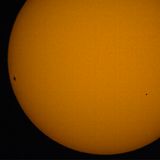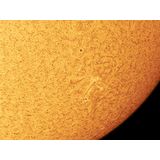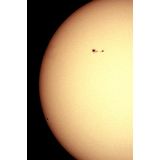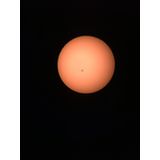
When you're ready to take your solar observing seriously, you're going to want the right words to describe what you're seeing in your personal reports and/or reports to others. While the following is not a complete list, they are common terms you will encounter most often along with a brief description of what they mean.
Corona - the outer, plasma layer of the solar atmosphere which can extend across a huge distance of space. It is observed during a solar eclipse.
Photosphere - the visible surface of the Sun. It is a solid shell of gas approximately 250 miles thick with an average temperature of 11,000° Fahrenheit.
Chromosphere - the middle layer of the solar atmosphere. It measures approximately 1245 miles in depth.
Limb darkening - seen at the edge of the photosphere. This effect occurs because at the center of the disc we see deeper into the Sun where the temperatures are higher and the gas shines more brightly. At the limb, we are seeing cooler gas at higher elevations, therefore it appears darker.
Granules - cells of gas seen at magnification. Individual cells of gas contained within the photosphere form into specific areas. Since they are formed due to dynamic activity, each granule may last from several minutes up to a half an hour.
Granulation - term used to describe the overall pattern of individual cells, usually observable at the limb. Granulation occurs in the photosphere.
Faculae - large, irregular patches on the photosphere. They are normally observable near the limb. Faculae appear as "cracks" or "veins" within the granulation pattern.
Prominence - a "loop" of cooler plasma observable with a hydrogen-alpha (H-alpha) filter. This dynamic activity is attached to the photosphere and extends outward through the corona. Prominences can form within hours and last over a wide timeline - from hours up to a year.
Flare - a brilliant explosion of pent-up magnetic energy and radiation which affects all three layers of the solar atmosphere. Narrow band H-alpha filters are capable of revealing them, but only very rare "white light" flares from especially energetic emissions can be detected in a standard filter or Herschel wedge.
Sunspots - a dark, highly magnetic "patch" on the solar surface where the mean temperatures are about 3,600 degrees cooler. This is where the Sun's magnetic field has emerged through the photosphere and stopped the rising energy from reaching the surface. They're easily visible in affordable "white light" glass and safety-film solar filters. Sunspots indicate where a prominence or flare is located.
Umbra - the darkest, coolest portion of a visible sunspot. These black areas vary greatly in size, shape, and magnetic field polarization.
Penumbra - a striated, lighter colored halo surrounding the central umbra. Also varies greatly in size and shape.
Dispersion field - a term used to describe the umbra/penumbra region of a sunspot group.
Plage - a bright region which occurs in the chromosphere. They are also a visible perimeter that usually accompanies a sunspot group.
Sunspot area - the area of a sunspot measured in millionths of the Sun's visible hemisphere.
Sunspot groups - a collection of sunspots. Normally it is fairly easy to count the number of groups as they are spread out across the disk and in both hemispheres, but difficulties can occur when sunspots appear close together. It is wise to check a reliable information source as to their given numerical designation.
Spicule - a jet of gas which occurs in the chromosphere. It is dynamic activity which is visible along the solar limb and lasts about 15 minutes.
"Wilson Effect" - term coined by Scottish solar astronomer, Alexander Wilson, who described the indented, dimpled appearance of highly magnetized sunspots when seen near the solar limb.
Coronal mass ejection - a CME is an intense burst of solar wind and magnetic fields which occurs above the corona. The released material consists of plasma - protons and electrons - and sometimes small quantities of other material such as helium, oxygen, and iron.
Coronal hole - a darker, cooler, less dense area in the plasma with open magnetic field lines. Widely accepted to be the major source of solar winds.
Solar cycle - a periodic change in solar activity, usually lasting approximately 11 years.
Solar Maximum - or solar max. Time frame during the 11 year cycle when solar activity is at its peak.
Sunspot Number - also known as the Wolf Number, or Zurich Number. It is the relative measure of individual or groups of sunspots present on the surface for a given date and time.
Again, there will be many more terms you will encounter as you broaden your knowledge of solar observing. In the meantime, enjoy each feature you see through a variety of properly protected astronomical instruments and use the proper terms to describe them!
CAUTION: Never view the Sun, even for an instant, without a properly installed protective solar filter for your telescope or binoculars, or specialized solar telescope. Doing so could permanently damage your eyes.
Tammy Plotner
Category: Seasonal
Astro-images taken through a telescope on a tracking mount provide breathtaking color and detail that you just can't see with your eyes alone. The astro-images on our web site demonstrate the imaging capabilities of the products used and are not intended to represent what you will see when you look through a telescope. Learn More
Some materials in our Resource Center require Adobe Reader. Download Adobe Reader here. Adobe Flash Player may be required to view some content. Download the Flash Player here.























